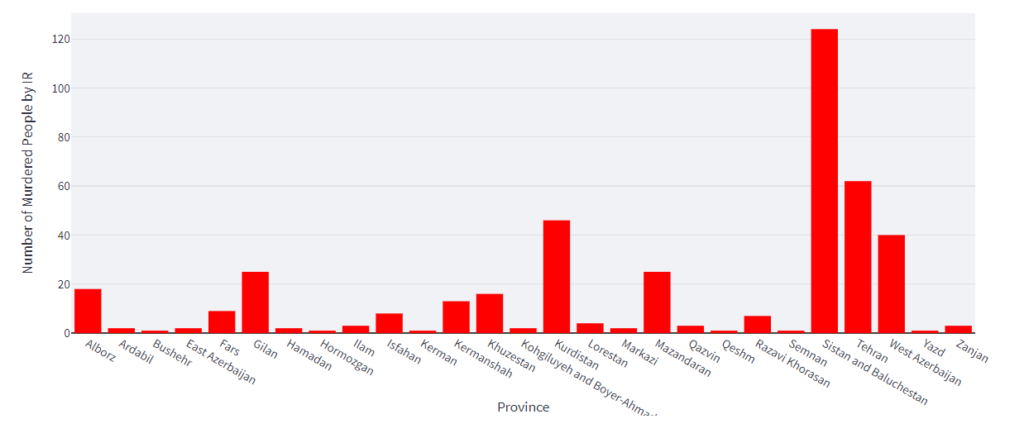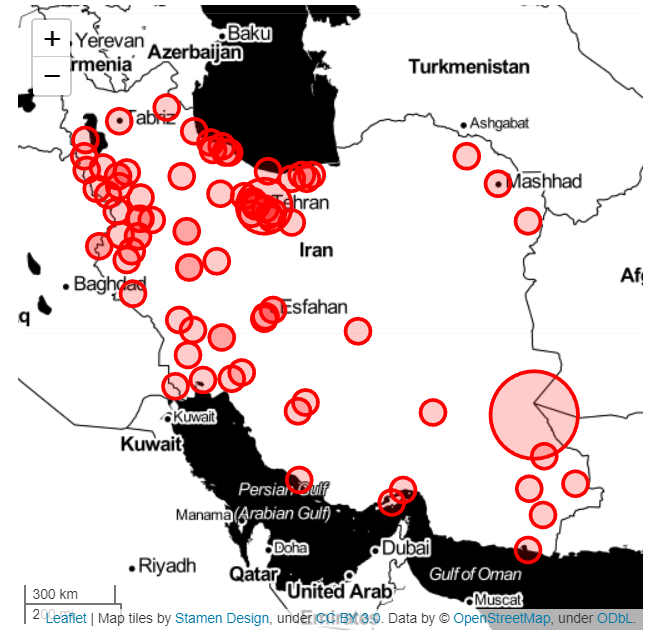Minds of the Movement
An ICNC blog on the people and power of civil resistance
by Seyedeh Faezeh AlaviJanuary 25, 2023
این مقاله همچنین به زبان انگلیسی در اینجا موجود است.
This article is also available in Farsi here
Shadowed by many breaking headlines and increasingly brutal repression, the Iranian revolution for secular democracy continues to forge ahead. Soon in its fifth month, the uprising has taken root across Iran. Its widening geographic spread and deepening diversity of participants have been met with an intensified crackdown ordered by the Islamic regime–evidence that its grip on power is slipping.
There is no such thing as open data in Iran (and many countries, for that matter) when it comes to domestic uprisings. However, this does not mean that the information that human rights organizations have obtained on protester imprisonment, killings and executions in Iran is incorrect. It means that real numbers are higher, perhaps much higher. Many families are being threatened by the regime forces to stay silent. Many are still looking for information about their missing relatives. In the current context, any effort to shed light on what’s really happening—especially in quantitative terms—becomes an act of nonviolent resistance in itself. This is the first goal of this post.
I then challenge the commonly held notion that repression is the end of resistance; instead, it forces activists to forge new nonviolent strategies to resist and persist. This is absolutely the case for Iranians at present, and we will see below how.
Lastly, I share lessons from past movements in Iran that are forming the foundation for the current uprising.
But first, let us examine the most recent numbers that allow us to begin to comprehend the Islamic regime’s crackdown on the ongoing pro-democracy and pro-human rights uprising that has shaken the country to its core.
Shedding light on repression amid darkness
Estimates of protester deaths vary from one source to another, due to the difficulties of obtaining verifiable data as well as varying cut-off dates for data. Based on the most recent report of the Human Rights Activists News Agency (HRANA), as of January 24, more than 19,000 individuals have been arrested in conjunction with protests (including 168 children under 18 years old), 527 protesters have been killed by the Iranian Revolutionary Guard Corps (IRGC) (including 71 children), and individuals involved in this uprising were residents of at least 164 cities across the country. We are unable to determine what percentage of arrested individuals were/are imprisoned.
According to sources such as HRANA and +1500 Tasvir, as of December 12, the provinces with the most number of protest-related deaths are Sistan and Baluchestan, followed by Tehran, Kurdistan, and West Azerbaijan, which shows that the protests are indeed nationwide and almost every state is engaged. Each repressed individual has a name and story, which regime forces are actively endeavoring to erase; this is why our data include as many personal details as possible and will be continually updated.

Click to enlarge. This graph shows the cities where people have been killed by the IRGC as of December 12, 2022 (approximately 40 days earlier than the HRANA data cited above, hence the variation). Source: ihumans.net. (#IranRevolution > Death Toll)

Click to enlarge. This map shows the cities where people have been killed by the IRGC, as of December 12, 2022. Source: ihumans.net (#IranRevolution > Map of Revolution > Zoom in or out for more detail).
New strategies of resistance and resilience
Facing a brutal crackdown that shows no signs of abating, the Iranian people have been testing not only different approaches to concentrated tactics (i.e. protests) but also dispersed strategies (i.e. boycotts) to pressure the regime. Beyond fine-tuning street action planning, Iranians both inside and outside the country are engaging in behaviors to weaken the economic pillars that prop up the regime. We’ve often read about the strikes of oil and gas company workers, but ordinary people are also withdrawing their money from banks, exchanging their rials for dollars or gold, and keeping their money in their homes.
These more dispersed actions have so far had a huge effect on the amount of money in the regime’s hands. They have forced high-ranking officials to denounce the actions or put restrictions on the amount of dollars every person can obtain from exchange stores. Such actions have the added advantage of reducing participant exposure to physical harm and thus reduce the barriers to participation in the revolution.
Iranians in the diaspora are also asking their receiving governments to designate the IRGC, the regime’s main army led by the supreme leader Ali Khamenei, as a terrorist organization. This is what the United States did some years ago, and on January 18, 2023, the EU Parliament voted to call for the EU and its member states to include the IRGC on the EU's terrorist list. This demand has the advantage of revealing the true face of the IRGC, and if more governments would concede to the designation demand, the Iranian regime would be increasingly isolated and its economic power increasingly compromised.
In addition, as we know, there is no real private sector in Iran. All of the big companies are owned by the IRGC, whether they are private or not. Therefore, Iranians started a boycott campaign (documented via the Twitter hashtag #اعتصاب_مشتری or “customer strike” in English) against companies such as DigiKala and Snapp, which are the Iranian versions of Amazon and Uber, respectively. The main point is to empty the pockets of the IRGC. In addition, because there are reports circulating via social media platforms showing that these companies are helping regime forces to identify protesters and repress them, it is very important to weaken those companies.
What Iranians have learned from previous movements
From the 1979 protest against mandatory Hijab rule, to the 2009 Green Revolution, to the 2019 protest against the whole Islamic regime, Iranians today have extensive organizing experience from which to draw. Some of the lessons they have learned include:
A struggle for freedom must be inclusive, if not universal
In past movements, when human rights issues were raised, some parties said: “Now is not the time. Let us focus on more important issues.” For example, one of the problems during the 1979 Islamic Revolution was the misguided notion promulgated in Muslim Communist circles that if we are forced to wear the Hijab in order to achieve freedom, we will absolutely accept it. So, certain groups had their own vague definition of freedom—a definition which ignores basic human rights while attempting to push forward to freedom! Iranians today will not fall for this kind of paradox. We know that freedom for only some is not true freedom.
Reformism is a trap
Before the creation of the reformist party in Iran, many people lost their faith in the regime. However, the regime managed to survive for many more years by tricking people with the idea of reform. When the 2009 Green Movement happened, many people participated in the protests, not because of their vote (many did not vote at all in the 2009 presidential election); instead, they came to the streets because they were hopeful that maybe this time they could see the regime fall.
As Iranian political activist Mehdi Hajati says, the aim of Iranian reformists never was to bring down the Islamic Republic regime; instead, reformists were there to distract people with less pressing problems. What happened in the Green Movement was the same: many people took to the streets because they thought they could weaken the supreme leader, whereas in reality, the regime used the oppression against people in the Green Movement as a tool to give more popularity to the reformist party… which has never—and will never—act against Ali Khamenei.
Regimes, not just movements, have learning curves as well
For sure, Iranians have learned from the challenges and shortcomings of past generations. They have also come to realize that the Iranian regime, too, has experimented with various coping strategies—what many specialists call the “dictators’ learning curve”. During previous uprisings, the regime attempted to infiltrate opposition groups, drawing on support of certain loyalist/lobbyist groups. Some groups known to be lobbying the regime have in recent weeks begun supporting the revolution, with conditions! To us, this indicates a certain fear that has settled in the regime’s camp; it believes its collapse is possible.
Thus, we might anticipate the regime’s next steps. If or once it falls, it will probably reorganize as new opposition parties, as a survival strategy. The Iranian people are already beginning to chant the name of the real opposition parties, and those parties are already uniting to be prepared for this eventuality.
-
As Karim Sadjadpour, Senior Fellow at the Carnegie Endowment for International Peace, points out, “The question is no longer about whether Iranians will topple Ali Khamenei but when.” Even facing harsh repression, Iranians are proving more resilient, savvy and united than ever to press forward towards freedom and a secular democracy.

Seyedeh Faezeh Alavi
Seyedeh Faezeh Alavi is an Iranian activist, artist, and MA student in Development Policy at KDI School of Public Policy and Management, South Korea. She is currently working on Human Rights and Sustainable Social Development at iHuman, an NGO that focuses on personal, organizational, and social development, mainly in Iran.
Read More